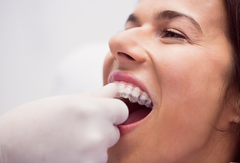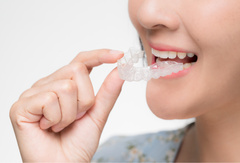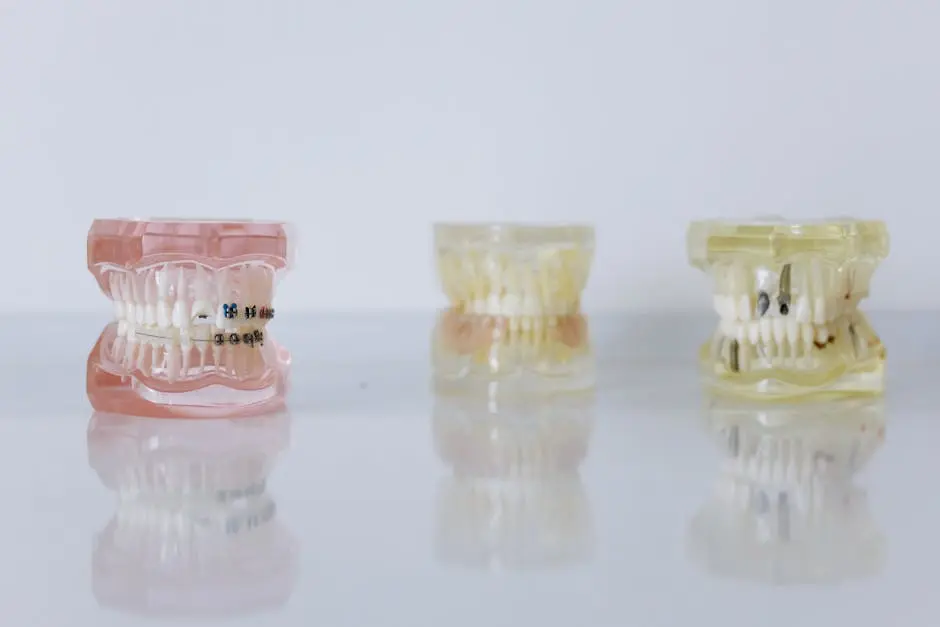Tooth Correction: Aligning Comfort with Convenience
In recent years, tooth correction methods have evolved significantly, providing patients with a variety of options that are both comfortable and convenient. Whether you’re considering braces, aligners, or other dental solutions, understanding the available choices can help you make an informed decision.
Understanding the Need for Tooth Correction
Tooth correction is essential for both aesthetic and health reasons. Misaligned teeth can lead to challenges in oral hygiene, causing potential health issues later on. For instance, crowded teeth make it difficult to properly clean each tooth, often resulting in plaque buildup and increasing the risk of tooth decay and gum disease. Moreover, misaligned bites can lead to jaw pain and headaches as they cause unnecessary stress on the jaw muscles according to the ADA.
With crooked teeth sometimes making oral care challenging, it’s no wonder that addressing dental alignment issues can significantly improve oral hygiene habits. Straight teeth mean better reach for your toothbrush and floss, helping prevent cavities and periodontal diseases down the road. It’s not just about keeping your smile picture-perfect; it’s also about keeping gum disease and cavities at bay. Multiple studies suggest the benefit of straighter teeth, emphasizing how important teeth alignment is to our overall systemic health.
Misaligned teeth aren’t just a cosmetic concern but a dental health discrepancy needing more attention. When our bite doesn’t fit together perfectly, it can lead to excessive wear and tear on specific teeth, potentially increasing the risk for teeth fractures and other dental injuries. Ensuring the alignment of our teeth and jaws can bring balance and uniformity to our oral systems, thereby preventing bite-related headaches and jaw joint disorder issues. As always, the consultation of a knowledgeable dental professional is invaluable when assessing if your teeth’s alignment could affect your health.
Traditional Braces: The Tried-and-True Solution
Traditional metal braces have long stood the test of time as a trustworthy method to address even the most complex tooth alignment concerns. Their ability to move teeth with precision makes them ideal for severe cases of misalignment or under- and overbites. A recent blog from Armbrecht & Wierenga Orthodontics highlights how these metal marvels are engineered to methodically align and straighten teeth by applying consistent pressure over an extended period, usually about 18 to 36 months, depending on the individual’s dental needs.
Despite their effectiveness, traditional braces do come with specific considerations. They require a level of commitment as changes in daily routines and diet are often necessary to accommodate the braces’ structure. Not eating hard or sticky foods, and adhering to a diligent cleaning regimen, are part of the package when undergoing correction with metal braces. However, in return for these sacrifices, patients receive a beautifully aligned smile and a healthy bite alignment that can last a lifetime. The initial slight discomfort often fades over time, with the knowledge that adjustments or tightening sessions are gradually bringing teeth into their desired positions.
For children and adults alike, the decision to opt for traditional braces involves balancing aesthetic concerns with practical outcomes. Some may be hesitant due to the metallic appearance, but many find comfort in knowing that braces are a socially accepted and common sight. Advancements in orthodontics have also paved the way for more discreet options, making them a compelling choice even for fashion-conscious patients. Understanding the lifestyle changes and time commitment involved is crucial when choosing traditional braces for orthodontic treatment.
The Rise of Clear Aligners
Recently, clear aligners have emerged as a hugely popular alternative due to their discretion and flexibility. Aligners allow wearers to remove them for eating and cleaning, which is a significant advantage over traditional braces. Their transparent materials are virtually invisible, appealing particularly to adults who wish to undergo orthodontic treatment without the noticeable appearance of metal brackets and wires. The rise in their popularity is a testament to the shift towards more patient-friendly orthodontic options as noted in Aligner’s blog.
Aligners also provide a flexible solution for patients looking to straighten their teeth without sacrificing appearance. Their design promotes better oral hygiene, as they can be removed when brushing and flossing. Furthermore, innovations in 3D imaging and digital modeling make these aligners highly customized, allowing for precise adjustments based on individual dental needs. The treatment can range from a few months to a few years, depending on individual cases, with the process typically involving a new set of aligners approximately every two weeks to progressively move teeth into their correct positions.
While they are not suitable for all cases, clear aligners provide a more convenient and comfortable alternative for many patients. An emphasis on a patient’s specific orthodontic needs is essential when considering them. They cater well to mild to moderate misalignment issues, offering a pathway to a straighter smile without the commitment of traditional braces. However, they may not be the best option for issues like severe bite misalignments. Discussing your treatment plan thoroughly with an experienced orthodontist will ensure that aligners are the right choice for your needs.
Cutting-Edge Technologies in Tooth Correction
Orthodontic technology has come a long way, with innovations such as 3D imaging, treatment modeling, and digital scans catapulting the field of tooth correction into the future. These advancements have reshaped how orthodontists assess and plan treatment paths, allowing for better diagnostics and more efficient, tailored treatment plans. With digital models, patients and orthodontists can now predict treatment outcomes with greater accuracy, ultimately shaping expectations and providing peace of mind before any physical work begins.
These modern technologies have had a profound impact on timeline and convenience, too. For instance, remote monitoring of progress via orthodontic apps allows patients to reduce physical visits, catering to today’s fast-paced, digitally connected lifestyles. This allows orthodontists to closely monitor treatments from a distance without compromising on quality care, an aspect especially valued during times when social distancing measures are required.
Additionally, the blend of emerging technologies with orthodontic care ensures that patient comfort remains at the forefront. Techniques continue to become less invasive, making treatments less painful and less embarrassing for those conscious about their appearance. It’s now possible to have your treatment process charted out digitally before committing to any physical adjustment, offering a reassuring glimpse into the future of your smile.
Incorporating cutting-edge technologies not only streamlines the tooth correction process but also ensures that patients can access solutions that are minimally intrusive yet maximally effective. If you’re contemplating dental corrections, staying tuned to the latest tech-savvy advancements in orthodontics will undoubtedly support a more informed and thoroughly satisfying treatment journey.
Selecting the Right Option for You
Choosing the right tooth correction option is a personal decision that depends on multiple factors, including the severity of tooth misalignment, personal preferences, lifestyle considerations, and budget. Traditional braces, often preferred for their ability to correct complex issues, remain an option for those needing significant correction. Their reliability speaks to the long-standing trust people place in this time-tested method. However, balancing the transformative benefits with lifestyle sacrifices is necessary, with attention to dietary restrictions and the visual aspect taken into account.
On the other hand, if you seek a more inconspicuous method, clear aligners present a compelling alternative. They afford the ease of removal, allowing for eating, brushing, and flossing without much hassle—an attractive attribute for those with active lifestyles or professional commitments that preclude more apparent treatments. However, they generally cater to mild to moderate alignment issues, so an initial consultation with a trusted orthodontist is key to determining if this treatment will be effective for you.
A consultation with a dental professional can clarify the best treatment route, especially as orthodontic technology continues to advance, offering options that might not have been available just a few years ago. Personalized treatment plans can be crafted to address specific questions and concerns, leveraging the continual enhancements in orthodontic approaches.
Ultimately, selecting the right option boils down to finding a balance between your aesthetic goals, practical concerns, and financial considerations. When making your decision, consider consulting with professionals in your area who can offer insights and estimates based on their extensive experience. Innovations in the field, such as digital treatment planning and remote monitoring, ensure that whether you opt for traditional braces or clear aligners, you’re making a well-rounded choice that accommodates modern conveniences without compromising results.
Ready to embark on your tooth correction journey? Begin exploring the possibilities with a comprehensive consultation. Discover more insights about moving away from dental misalignment and consider personalized solutions that best fit your needs.
Achieving a Beautiful Smile: Comfort Meets Convenience
Tooth correction doesn’t have to mean compromising comfort for aesthetics. With modern advancements, achieving a beautiful smile is more convenient and comfortable than ever. Consult with your dental professional to explore the best options tailored to your needs.

Latest Blog
-
 Oct 17, 2025
Oct 17, 2025Cost Breakdown: Clear Aligners vs Veneers Which Is Worth Your Money in 2025?
Learn More -
 Oct 16, 2025
Oct 16, 2025Invisible Braces vs. Clear Aligners: Differences in Treatment Time and Comfort
Learn More -
 Oct 15, 2025
Oct 15, 2025Best Invisible Braces for Adults in 2025: Comfortable, Affordable, and Effective Choices
Learn More -


 USA
USA Canada
Canada UK
UK Italy
Italy Sweden
Sweden Australia
Australia





